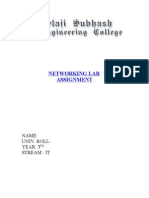Computer Networks (CS425) : Unix Socket Programming (Contd..)
Uploaded by
Anish VeettiyankalComputer Networks (CS425) : Unix Socket Programming (Contd..)
Uploaded by
Anish Veettiyankal11/8/2014
CS425: Computer Networks : Lecture 18
Computer Networks (CS425)
Instructor: Dr. Dheeraj Sanghi
Prev | Next | Index
Unix Socket Programming (Contd..)
Client-Server Communication Overview
The analogy given below is often very useful in understanding many such networking concepts. The
analogy is of a number of people in a room communicating with each other by way of talking. In a
typical scenario, if A has to talk to B, then he would call out the name of B and only if B was listening
would he respond. In case B responds, then one can say that a connection has been established.
Henceforth until both of them desire to communicate, they can carry out their conversation.
A Client-Server architecture generally employed in networks is also very similar in concept. Each
machine can act as a client or a server.
Server: It is normally defined which provides some sevices to the client programs. However, we will
have a deeper look at the concept of a "service" in this respect later. The most important feature of a
server is that it is a passive entiry, one that listens for request from the clients.
Client: It is the active entity of the architecture, one that generated this request to connect to a particular
port number on a particular server
Communication takes the form of the client process sending a message over the network to the server
process. The client process then waits for a reply message. When the server process gets the request, it
performs the requested work and sends back a reply.The server that the client will try to connect to
should be up and running before the client can be executed. In most of the cases, the servers runs
continuously as a daemon.
There is a general misconception that servers necessarily provide some service and is therefore called a
server. For example an e-mail client provides as much service as an mail server does. Actually the term
service is not very well defined. So it would be better not to refer to the term at all. In fact servers can be
programmed to do practically anything that a normal application can do. In brief, a server is just an entity
that listens/waits for requests.
To send a request, the client needs to know the address of the server as well as the port number which has
to be supplied to establish a connection. One option is to make the server choose a random number as a
port number, which will be somehow conveyed to the client. Subsequently the client will use this port
number to send requests. This method has severe limitations as such information has to be communicated
offline, the network connection not yet being established. A better option would be to ensure that the
server runs on the same port number always and the client already has knowledge as to which port
provides which service. Such a standardization already exists. The port numbers 0-1023 are reserved for
the use of the superuser only. The list of the services and the ports can be found in the file /etc/services.
http://www.cse.iitk.ac.in/users/dheeraj/cs425/lec18.html
1/6
11/8/2014
CS425: Computer Networks : Lecture 18
Connection Oriented vs Connectionless Communication
Connection Oriented Communication
Analogous to the telephone network.The sender requests for a communication (dial the number), the
receiver gets an indication (the phone ring) the receiver accepts the connection (picks up the phone) and
the sender receives the acknowledgment (the ring stops). The connection is established through a
dedicated link provided for the communication. This type of communication is characterized by a high
level of reliability in terms of the number and the sequence of bytes.
Connectionless Communication
Analogous to the postal service. Packets(letters) are sent at a time to a particular destination. For greater
reliability, the receiver may send an acknowledgement (a receipt for the registered letters).
Based on this two types of communication, two kinds of sockets are used:
stream sockets: used for connection-oriented communication, when reliability in connection is
desired.
datagram sockets: used for connectionless communication, when reliability is not as much as an
issue compared to the cost of providing that reliability. For eg. streaming audio/video is always
send over such sockets so as to diminish network traffic.
Sequence of System Calls for Connection Oriented communication
The typical set of system calls on both the machines in a connection-oriented setup is shown in Figure
below.
http://www.cse.iitk.ac.in/users/dheeraj/cs425/lec18.html
2/6
11/8/2014
CS425: Computer Networks : Lecture 18
The sequence of system calls that have to be made in order to setup a connection is given below.
1. The socket system call is used to obtain a socket descriptor on both the client and the server. Both
these calls need not be synchronous or related in the time at which they are called.The synopsis is
given below:
#include<sys/types.h>
#include<sys/socket.h>
int socket(int domain, int type, int protocol);
2. Both the client and the server 'bind' to a particular port on their machines using the bind system
call. This function has to be called only after a socket has been created and has to be passed the
socket descriptor returned by the socket call. Again this binding on both the machines need not be
in any particular order. Moreover the binding procedure on the client is entirely optional. The bind
system call requires the address family, the port number and the IP address. The address family is
known to be AF_INET, the IP address of the client is already known to the operating system. All
that remains is the port number. Of course the programmer can specify which port to bind to, but
this is not necessary. The binding can be done on a random port as well and still everything would
work fine. The way to make this happen is not to call bind at all. Alternatively bind can be called
with the port number set to 0. This tells the operating system to assign a random port number to
this socket. This way whenever the program tries to connect to a remote machine through this
socket, the operating system binds this socket to a random local port. This procedure as mentioned
above is not applicable to a server, which has to listen at a standard predetermined port.
3. The next call has to be listen to be made on the server. The synopsis of the listen call is given
http://www.cse.iitk.ac.in/users/dheeraj/cs425/lec18.html
3/6
11/8/2014
CS425: Computer Networks : Lecture 18
below.
#include<sys/socket.h>
int listen(int skfd, int backlog);
skfd is the socket descriptor of the socket on which the machine should start listening.
backlog is the maximum length of the queue for accepting requests.
The connect system call signifies that the server is willing to accept connections and thereby start
communicating.
Actually what happens is that in the TCP suite, there are certain messages that are sent to and fro
and certain initializations have to be performed. Some finite amount of time is required to setup the
resources and allocate memory for whatever data structures that will be needed. In this time if
another request arrives at the same port, it has to wait in a queue. Now this queue cannot be
arbitrarily large. After the queue reaches a particular size limit no more requests are accepted by
the operating system. This size limit is precisely the backlog argument in the listen call and is
something that the programmer can set. Today's processors are pretty speedy in their computations
and memory allocations. So under normal circumstances the length of the queue never exceeds 2
or 3. Thus a backlog value of 2-3 would be fine, though the value typically used is around 5.Note
that this call is different from the concept of "parallel" connections.The established connections are
not counted in n. So, we may have 100 parallel connection running at a time when n=5.
4. The connect function is then called on the client with three arguments, namely the socket
descriptor, the remote server address and the length of the address data structure. The synopsis of
the function is as follows:
#include<sys/socket.h>
#include<netinet/in.h> /* only for AF_INET , or the INET Domain */
int connect(int skfd, struct sockaddr* addr, int addrlen);
This function initiates a connection on a socket.
skfd is the same old socket descriptor.
addr is again the same kind of structure as used in the bind system call. More often than not, we
will be creating a structure of the type sockaddr_in instead of sockaddr and filling it with
appropriate data. Just while sending the pointer to that structure to the connect or even the bind
system call, we cast it into a pointer to a sockaddr structure. The reason for doing all this is that the
sockaddr_in is more convenient to use in case of INET domain applications. addr basically
contains the port number and IP address of the server which the local machine wants to connect to.
This call normally blocks until either the connection is established or is rejected.
addrlen is the length of the socket address structure, the pointer to which is the second argument.
5. The request generated by this connect call is processed by the remote server and is placed in an
operating system buffer, waiting to be handed over to the application which will be calling the
accept function. The accept call is the mechanism by which the networking program on the server
http://www.cse.iitk.ac.in/users/dheeraj/cs425/lec18.html
4/6
11/8/2014
CS425: Computer Networks : Lecture 18
receives that requests that have been accepted by the operating system. This synopsis of the accept
system call is given below.
#include<sys/socket.h>
int accept(int skfd, struct sockaddr* addr, int addrlen);
skfd is the socket descriptor of the socket on which the machine had performed a listen call and
now desires to accept a request on that socket.
addr is the address structure that will be filled in by the operating system by the port number and
IP address of the client which has made this request. This sockaddr pointer can be type-casted to a
sockaddr_in pointer for subsequent operations on it.
addrlen is again the length of the socket address structure, the pointer to which is the second
argument.
This function accept extracts aconnection on the buffer of pending connections in the system,
creates a new socket with the same properties as skfd, and returns a new file descriptor for the
socket.
In fact, such an architecture has been criticized to the extent that the applications do not have a say
on what connections the operating system should accept. The system accepts all requests
irrespective of which IP, port number they are coming from and which application they are for. All
such packets are processed and sent to the respective applications, and it is then that the application
can decide what to do with that request.
The accept call is a blocking system call. In case there are requests present in the system buffer,
they will be returned and in case there aren't any, the call simply blocks until one arrives.
This new socket is made on the same port that is listening to new connections. It might sound a bit
weird, but it is perfectly valid and the new connection made is indeed a unique connection.
Formally the definition of a connection is
connection:
defined as a 4-tuple : (Local IP, Local port, Foreign IP, Foreign port)
For each connection at least one of these has to be unique. Therefore multiple connections on one
port of the server, actually are different.
6. Finally when both connect and accept return the connection has been established.
7. The socket descriptors that are with the server and the client can now be used identically as a
normal I/O descriptor. Both the read and the write calls can be performed on this socket descriptor.
The close call can be performed on this descriptor to close the connection. Man pages on any
UNIX type system will furnish further details about these generic I/O calls.
8. Variants of read and write also exist, which were specifically designed for networking
applications. These are recv and send.
#include<sys/socket.h>
int recv(int skfd, void *buf, int buflen, int flags);
http://www.cse.iitk.ac.in/users/dheeraj/cs425/lec18.html
5/6
11/8/2014
CS425: Computer Networks : Lecture 18
int send(int skfd, void *buf, int buflen, int flags);
Except for the flags argument the rest is identical to the arguments of the read and write calls.
Possible values for the flags are:
used for
macro for the flag
recv
MSG_PEEK
send
MSG_DONT_ROUTE
recv &
send
MSG_OOB
comment
look at the message in the buffer but do not
consider it read
send message only if the destination is on the
same network, i.e. directly connected to the
local machine.
used for transferring data out of sequence,
when some bytes in a stream might be more
important than others.
9. To close a particular connection the shutdown call can also be used to achieve greater flexibility.
#include<sys/socket.h>
int shutdown(int skfd, int how);
skfd is the socket descriptor of the socket which needs to be closed.
how can be one of the following:
SHUT_RD
or 0 stop all read operations on this socket, but continue writing
SHUT_WR
or 1 stop all write operations on this socket, but keep receiving data
SHUT_RDWR or 2 same as close
A port can be reused only if it has been closed completely.
Image References
http://publib.boulder.ibm.com/iseries/v5r1/ic2924/info/rzab6/rxab6502.gif
back to top
Prev| Next | Index
.
http://www.cse.iitk.ac.in/users/dheeraj/cs425/lec18.html
6/6
You might also like
- The Gilliam Autism Rating Scale GARS - 2 A Pilot S100% (1)The Gilliam Autism Rating Scale GARS - 2 A Pilot S2 pages
- Assignment of Network Programming (IT-520)No ratings yetAssignment of Network Programming (IT-520)6 pages
- BTech(CSE)_8th _NS_Shiv Kumar Chaudhary KurmiNo ratings yetBTech(CSE)_8th _NS_Shiv Kumar Chaudhary Kurmi32 pages
- LABSHEET-2 Introduction To Network Programming and Writing A Simple Daytime Client-Server100% (1)LABSHEET-2 Introduction To Network Programming and Writing A Simple Daytime Client-Server15 pages
- Ocket-Server.c: Int Void Int Struct Char IntNo ratings yetOcket-Server.c: Int Void Int Struct Char Int8 pages
- Tutorial On Socket Programming: Computer Networks - CSC 458 Department of Computer Science Pooyan HabibiNo ratings yetTutorial On Socket Programming: Computer Networks - CSC 458 Department of Computer Science Pooyan Habibi28 pages
- Inter-Process Communication Flow Computer Network Internet ProtocolNo ratings yetInter-Process Communication Flow Computer Network Internet Protocol3 pages
- Socket Programming (Programming A Simple Server) in C++: Int Socket (Int Domain, Int Type, Int Protocol)No ratings yetSocket Programming (Programming A Simple Server) in C++: Int Socket (Int Domain, Int Type, Int Protocol)11 pages
- Socket Programming: 15-441 Computer Networks, Spring 2008 Xi LiuNo ratings yetSocket Programming: 15-441 Computer Networks, Spring 2008 Xi Liu39 pages
- Networked Applications: Sockets: COS 461: Computer Networks Spring 2006 (MW 1:30-2:50 in Friend 109)No ratings yetNetworked Applications: Sockets: COS 461: Computer Networks Spring 2006 (MW 1:30-2:50 in Friend 109)39 pages
- Networked Applications: Sockets: COS 461: Computer NetworksNo ratings yetNetworked Applications: Sockets: COS 461: Computer Networks38 pages
- Ix Ne TW Ork Gra MM Ing: R.H.Goudar Associate Professor, Dept. of CS/ITNo ratings yetIx Ne TW Ork Gra MM Ing: R.H.Goudar Associate Professor, Dept. of CS/IT55 pages
- I. Introduction To Socket Programming: Struct SockaddrNo ratings yetI. Introduction To Socket Programming: Struct Sockaddr74 pages
- Networking Lab Assignment: Name: Univ. Roll: Year: 3 Stream: ItNo ratings yetNetworking Lab Assignment: Name: Univ. Roll: Year: 3 Stream: It14 pages
- Berkeley Sockets: Prof. Indranil Sen Gupta Department of Computer Science & Engg. I.I.T. KharagpurNo ratings yetBerkeley Sockets: Prof. Indranil Sen Gupta Department of Computer Science & Engg. I.I.T. Kharagpur12 pages
- ceng204_w7_systems_programming2024_springNo ratings yetceng204_w7_systems_programming2024_spring22 pages
- Computer Networking Interview Question and Answer PDFNo ratings yetComputer Networking Interview Question and Answer PDF30 pages
- Computer Networks (CS425) : Transport Layer ProtocolNo ratings yetComputer Networks (CS425) : Transport Layer Protocol3 pages
- Computer Networks (CS425) : Unix Socket ProgrammingNo ratings yetComputer Networks (CS425) : Unix Socket Programming4 pages
- Jason Dela Cruz Jose": IT Engineer / Systems EngineerNo ratings yetJason Dela Cruz Jose": IT Engineer / Systems Engineer3 pages
- Computer Networks (CS425) : Transport Layer Protocol-Implementation IssuesNo ratings yetComputer Networks (CS425) : Transport Layer Protocol-Implementation Issues5 pages
- Computer Networks (CS425) : ISO-OSI 7-Layer Network ArchitectureNo ratings yetComputer Networks (CS425) : ISO-OSI 7-Layer Network Architecture5 pages
- Computer Networks (CS425) : Transport Layer Protocol (Continued)No ratings yetComputer Networks (CS425) : Transport Layer Protocol (Continued)4 pages
- Computer Networks (CS425) : ARP, RARP, ICMP ProtocolsNo ratings yetComputer Networks (CS425) : ARP, RARP, ICMP Protocols7 pages
- Computer Networks (CS425) : Instructor: Dr. Dheeraj SanghiNo ratings yetComputer Networks (CS425) : Instructor: Dr. Dheeraj Sanghi6 pages
- Computer Networks (CS425) : Instructor: Dr. Dheeraj SanghiNo ratings yetComputer Networks (CS425) : Instructor: Dr. Dheeraj Sanghi7 pages
- Computer Networks (CS425) : Data EncodingNo ratings yetComputer Networks (CS425) : Data Encoding7 pages
- Computer Networks (CS425) : IEEE 802.3 and EthernetNo ratings yetComputer Networks (CS425) : IEEE 802.3 and Ethernet3 pages
- Computer Networks (CS425) : Routing AlgorithmsNo ratings yetComputer Networks (CS425) : Routing Algorithms5 pages
- Robert Arias 20163930 Ubuntu Test 2 - ZnhxabNo ratings yetRobert Arias 20163930 Ubuntu Test 2 - Znhxab38 pages
- Palo Alto PCNSE New Exam Questions Updated in Nov - 2022No ratings yetPalo Alto PCNSE New Exam Questions Updated in Nov - 202228 pages
- DHCP Server on Mikrotik_ Step by Step CompleteNo ratings yetDHCP Server on Mikrotik_ Step by Step Complete9 pages
- Understanding Cisco Data Center Foundations DcfnduNo ratings yetUnderstanding Cisco Data Center Foundations Dcfndu6 pages
- IMS Basic Signaling Procedure SIP IMS ProceduresNo ratings yetIMS Basic Signaling Procedure SIP IMS Procedures66 pages
- How To Configure DHCP in Cisco Packet TracerNo ratings yetHow To Configure DHCP in Cisco Packet Tracer12 pages
- HP 6127XLG Blade Switch Series: Fcoe Configuration GuideNo ratings yetHP 6127XLG Blade Switch Series: Fcoe Configuration Guide184 pages
- SDES RFC 4568 - Session Description Protocol (SDP) Security Descriptions For Media StreamsNo ratings yetSDES RFC 4568 - Session Description Protocol (SDP) Security Descriptions For Media Streams1 page
- Penawaran MetroNet PT. Mulya Adhi ParamitaNo ratings yetPenawaran MetroNet PT. Mulya Adhi Paramita2 pages
- 6.2.3.8 Packet Tracer - Router and Switch RedundancyNo ratings yet6.2.3.8 Packet Tracer - Router and Switch Redundancy4 pages
- CloudStorm XP 100GE Application and Security Test Load ModuleNo ratings yetCloudStorm XP 100GE Application and Security Test Load Module9 pages
- The Gilliam Autism Rating Scale GARS - 2 A Pilot SThe Gilliam Autism Rating Scale GARS - 2 A Pilot S
- LABSHEET-2 Introduction To Network Programming and Writing A Simple Daytime Client-ServerLABSHEET-2 Introduction To Network Programming and Writing A Simple Daytime Client-Server
- Tutorial On Socket Programming: Computer Networks - CSC 458 Department of Computer Science Pooyan HabibiTutorial On Socket Programming: Computer Networks - CSC 458 Department of Computer Science Pooyan Habibi
- Inter-Process Communication Flow Computer Network Internet ProtocolInter-Process Communication Flow Computer Network Internet Protocol
- Socket Programming (Programming A Simple Server) in C++: Int Socket (Int Domain, Int Type, Int Protocol)Socket Programming (Programming A Simple Server) in C++: Int Socket (Int Domain, Int Type, Int Protocol)
- Socket Programming: 15-441 Computer Networks, Spring 2008 Xi LiuSocket Programming: 15-441 Computer Networks, Spring 2008 Xi Liu
- Networked Applications: Sockets: COS 461: Computer Networks Spring 2006 (MW 1:30-2:50 in Friend 109)Networked Applications: Sockets: COS 461: Computer Networks Spring 2006 (MW 1:30-2:50 in Friend 109)
- Networked Applications: Sockets: COS 461: Computer NetworksNetworked Applications: Sockets: COS 461: Computer Networks
- Ix Ne TW Ork Gra MM Ing: R.H.Goudar Associate Professor, Dept. of CS/ITIx Ne TW Ork Gra MM Ing: R.H.Goudar Associate Professor, Dept. of CS/IT
- I. Introduction To Socket Programming: Struct SockaddrI. Introduction To Socket Programming: Struct Sockaddr
- Networking Lab Assignment: Name: Univ. Roll: Year: 3 Stream: ItNetworking Lab Assignment: Name: Univ. Roll: Year: 3 Stream: It
- Berkeley Sockets: Prof. Indranil Sen Gupta Department of Computer Science & Engg. I.I.T. KharagpurBerkeley Sockets: Prof. Indranil Sen Gupta Department of Computer Science & Engg. I.I.T. Kharagpur
- Computer Networking Interview Question and Answer PDFComputer Networking Interview Question and Answer PDF
- Computer Networks (CS425) : Transport Layer ProtocolComputer Networks (CS425) : Transport Layer Protocol
- Computer Networks (CS425) : Unix Socket ProgrammingComputer Networks (CS425) : Unix Socket Programming
- Jason Dela Cruz Jose": IT Engineer / Systems EngineerJason Dela Cruz Jose": IT Engineer / Systems Engineer
- Computer Networks (CS425) : Transport Layer Protocol-Implementation IssuesComputer Networks (CS425) : Transport Layer Protocol-Implementation Issues
- Computer Networks (CS425) : ISO-OSI 7-Layer Network ArchitectureComputer Networks (CS425) : ISO-OSI 7-Layer Network Architecture
- Computer Networks (CS425) : Transport Layer Protocol (Continued)Computer Networks (CS425) : Transport Layer Protocol (Continued)
- Computer Networks (CS425) : ARP, RARP, ICMP ProtocolsComputer Networks (CS425) : ARP, RARP, ICMP Protocols
- Computer Networks (CS425) : Instructor: Dr. Dheeraj SanghiComputer Networks (CS425) : Instructor: Dr. Dheeraj Sanghi
- Computer Networks (CS425) : Instructor: Dr. Dheeraj SanghiComputer Networks (CS425) : Instructor: Dr. Dheeraj Sanghi
- Computer Networks (CS425) : IEEE 802.3 and EthernetComputer Networks (CS425) : IEEE 802.3 and Ethernet
- Palo Alto PCNSE New Exam Questions Updated in Nov - 2022Palo Alto PCNSE New Exam Questions Updated in Nov - 2022
- Understanding Cisco Data Center Foundations DcfnduUnderstanding Cisco Data Center Foundations Dcfndu
- HP 6127XLG Blade Switch Series: Fcoe Configuration GuideHP 6127XLG Blade Switch Series: Fcoe Configuration Guide
- SDES RFC 4568 - Session Description Protocol (SDP) Security Descriptions For Media StreamsSDES RFC 4568 - Session Description Protocol (SDP) Security Descriptions For Media Streams
- 6.2.3.8 Packet Tracer - Router and Switch Redundancy6.2.3.8 Packet Tracer - Router and Switch Redundancy
- CloudStorm XP 100GE Application and Security Test Load ModuleCloudStorm XP 100GE Application and Security Test Load Module
















































































































